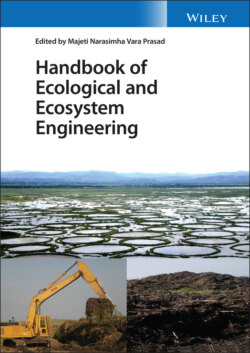Читать книгу Handbook of Ecological and Ecosystem Engineering - Группа авторов - Страница 28
2.2.6 Waterlogging
ОглавлениеDescription of the marginality factor: Waterlogging means excess water in the root zone. Excessive soil moisture adversely affects crop growth and development by causing restricting rooting conditions and low‐oxygen stress and reducing soil strength for workability and trafficability [10, 107]. Flooding induces changes in soil pH and redox potential [108]. Today this factor affects up to 10% of global land area [109].
Revitalization by ecosystem engineering: Flooding tolerance found in halophytes and glycophytes is often associated with the production of adventitious roots containing aerenchyma, resulting in an internal supply of O2 and preventing anoxia in tissue [110]. Flooding causes a reduction in the photosynthetic capacity of many plants, such as L. perenne [108]. Waterlogged marginal land can be revitalized through the adaptation and growth of plants for biomass production.
Flooded soils are characterized by the absence of oxygen and reduced chemical conditions. The adaptation of a plant species to these conditions depends on the growth capacity of its roots and its aeration. The effectiveness of aeration within the roots of plant species such as Vetiveria zizanoides, wetland grass species, sorghum, maize, and sugarcane is determined by: (i) anatomical characteristics such as the length of the aerenchyma, dimensions of the stele, cortical cell layout pattern, and existence of barriers to radial O2 losses; (ii) morphological characteristics such as root diameter and the number of lateral roots; and (iii) physiological processes, such as respiratory demand for oxygen [111]. Sunflowers and maize also display adaptations to flooded conditions/low levels of oxygen in the soil, such as elongation of the roots and inhibition/reduction of the growth aerial plant components [112]. Aquaporin genes of Sorghum bicolor L. seem to be related to the answer to waterlogging stress [113]. Liu and Jiang [114] reported that waterlogging and submergence stress decreased the root activity of SOD, catalase, peroxidase, and ascorbate peroxidase in perennial ryegrasses, indicating that maintaining antioxidant activity and carbohydrate and minimizing lipid peroxidation could contribute to better waterlogging and submergence tolerance in that bioenergy crop. Giant reed quickly adapts to flooding conditions with the absence of oxygen. After prolonged oxygen scarcity, the species can readjust and restore its physiological conditions. Depending on the severity of the stress, it can adapt its uptake of photosynthetic CO2, related to a combination of stomatal and mesophyll diffusional constraints [115]. Japanese sugarcane and S. bicolor are pointed out as bioenergy crops tolerant to multiple environmental stresses in marginal land, tolerating waterlogging conditions [116].
